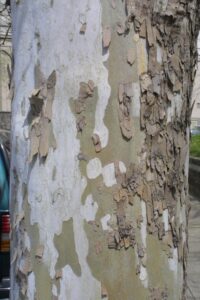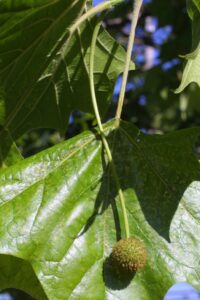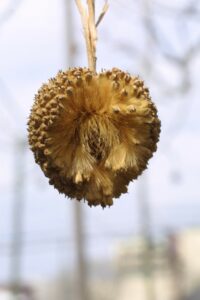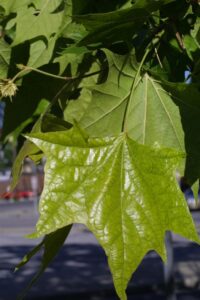Botanical Name:
Platanus occidentalis
Family Name:
Platanaceae / planetree
Description:
The sycamore is a large, long-lived, majestic tree best recognized by its mottled bark: gray sloughs off to reveal bone-white below. Green and brown hues are not uncommon. Some sycamores grow multiple trunks, rising to a sprawling canopy excellent for shade and wildlife habitat.
Size:
75 – 100′
Habitat and Range:
Sycamore trees are native to eastern North America and can be encountered from the mountains of Mexico to southern Ontario, from Maine to Florida and Texas. This water-loving tree often abides streamside, in riparian and wetland areas.
Attributes:
Sycamore leaves are three- to -five lobed and can be enormous, resembling giant maple-like leaves. They are sensitive to
late freezes in spring. In autumn they fade yellow, bronze, brown before falling.
Wildlife Value:
Sycamores are home for many species of birds, insect pollinators, and small mammals. Because of their grand stature and proximity to water, sycamore trees are an apt choice for Great Blue Heron rookeries.
Did you Know?
• Sycamores are ancient trees, dated by paleobotanists to 100+ million years ago.
• They have earned various nicknames including buttonball tree (for the spherical seed heads they drop in the fall) and ghost tree (for their pale bark).
• People have found lots of uses for this tree: dugout canoes, barrels, cabinets, shade — planting them often on parkways for their speedy growth and adaptability to urban environments.
• Sycamore sap can be tapped like that of a maple, with butterscotch overtones.
Benefits to Our Community (based on carbon dioxide sequestered, storm water runoff avoided, and air pollution removed each year):
Over the next 15 years, this tree will give back $5,070 worth of benefits to our community.




